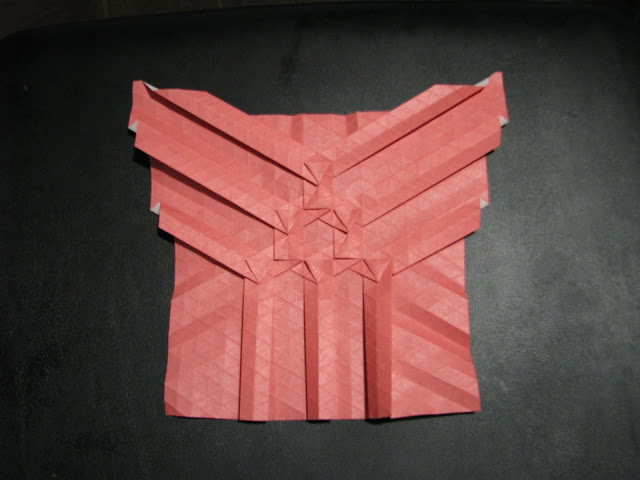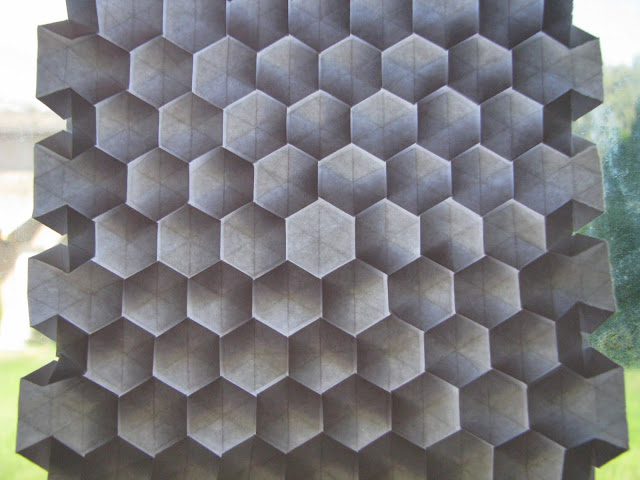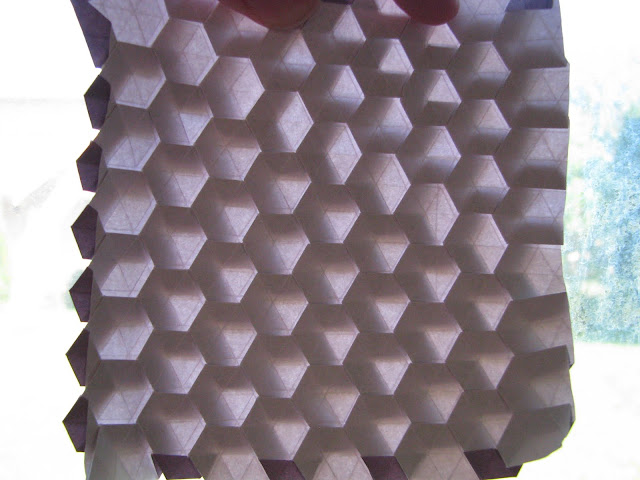Lately I've been enjoying the challenge of folding origami tessellations. From what I can find on the topic, Eric Gjerde is one of the leading individuals. He has a great Web site where he has posted quite a bit on the topic. I first stumbled upon his site and work several years ago and the pictures he had blew my mind. I thought, "Wow, he's incredible. There's no way I'd ever be able to that." While, I still think that about some of his most impressive work, I decided a short while later to try and tackle some of the "easier" designs. That was easy to do since Eric posts instructions for folding several of his designs on his site. He allows for anyone to go and download the instructions (in PDF form) free of charge with the stipulation that you aren't doing it for monetary gain and that you give him credit for the design.
Eric now has a book published titled Origami Tessellations: Awe-Inspiring Geometric Designs . I haven't had the privilege of owning this book, yet, but look forward to it. The couple of designs that I have folded came from the Web site, and they are a fun challenge.
. I haven't had the privilege of owning this book, yet, but look forward to it. The couple of designs that I have folded came from the Web site, and they are a fun challenge.
Once the tessellations are folded, they are visually very pleasing on the front; but if the reverse side is shown it too has very nice patterns. That would be enough of a reason for me to fold and enjoy these models. However if you then hold the completed tessellation up to a window, or put it on a light table, yet another wonderful pattern appears. And yet again a fourth pattern can be seen if the reverse side is seen while back-lit. All-in-all tessellations are a lot of fun. Here are some of the first patterns that I've folded.
 |
| A Double Pleat Hexagon Tessellation designed by Eric Gjerde. This design has two fairly distinct patterns that are created; the six-pointed stars made by the small triangle and the hexagons below them. |
 |
| The reverse side of the Double Pleat Hexagon Tessellation above. It forms a fun honeycomb pattern. |
 |
| The front side of the Double Pleat Hexagon Tessellation held up to a window to give the back-lit pattern. The small hexagons become all the more apparent; they can be seen in the first picture by looking at the center of the six-pointed stars. |
 |
| The reverse side of the Double Pleat Hexagon Tessellation back-lit. While the actual pattern here isn't much different from the previous picture, it does soften the edges of the hexagons giving it a little bit of a variation. |
 |
| This is the same piece of paper that's pictured above of the Double Pleat Hexagon Tessellation, its just in process of folding. I was half tempted to stop folding at this point with how much I liked the pattern that was created; but I got too curious as to what the final product would look like. I'll probably fold another with the intent to stop at this point. |
 |
| Eric Gjerde titled this the Spread Hexagon Tessellation. This is actually the first model that I attempted a few years ago (not this particular piece of paper; my first one wasn't nearly this good). I enjoy how all of the overlapping hexagons spread out and twist away from the top-most hexagon. |
 |
| The reverse side of the above Spread Hexagon Tessellation. A honeycomb pattern is formed here as in the model above; there are more hexagons and they are smaller here. |
 |
| The Spread Hexagon Tessellation held to the window for back-lighting. By doing this, the twisting effect of each successive layer of hexagons is easier to see. |
 |
| The reverse side of the Spread Hexagon Tessellation with back-lighting. I love that a totally different pattern is created on the reverse side than what you find on the front; although it is possible to see the same pattern if you look for it. |
 |
| The Spread Hexagon Tessellation folded slightly differently. Here, instead of starting in the middle of the paper with the top-most hexagon, I decided to see what it would look like if I started in one corner. It reminds me more of scales on a fish or maybe a dragon. I didn't take a picture of the reverse side, because it looks identical to the reverse side of the previous Spread Hexagon Tessellation. |
 |
| The back-lit purple Spread Hexagon Tessellation. |
 |
| The reverse side of the purple Spread Hexagon Tessellation. As with the Double Pleat Hexagon Tessellation that was back-lit, the pattern is the same but the edges are softened. |
 |
| A close up picture of the Spread Hexagon Tessellation (the white one above). |
These next pictures are tessellation, though not from Eric Gjerde. The creator of this next model is Shuzo Fujimoto. The only instructions that I've been able to locate are in video form
here. The folder is Sara Adams; she has a very nice
Web site, as well as a
YouTube channel. Something I particularly enjoy about Sara is that she gets permission from the origami artist that created a model before posting videos of how to perform the folding. Anyways, here is Shuzo Fujimoto's
Hydrangea model.
 |
| Shuzo Fujimoto's Hydrangea. I folded this during church one week; it took me about an hour to do. There were two young girls sitting in front of us; unfortunately I think I may have had more of their attention as I was folding this than the speaker. This was folded from a sheet of origami paper about 6 inches square. |
 |
| A variation of the Hydrangea. I saw a picture of this online once and decided to try it. There are some very impressive versions of multiple Hydrangeas folded from a single sheet of paper. This is only folded to the third layer. |
 |
| The Hydrangea folded to the fifth layer. This is folded from about a 11 inch square sheet of paper. Its a little easier to see how this can be considered a tessellation with this many steps. Each step in the tessellation is a cross that is rotated 90 degrees from the step before and a little smaller. |
 |
| The reverse side of the 5-layer Hydrangea. Here, again, the reverse side has its own pattern to offer. |
 |
| The reverse side of the 5-layer Hydrangea held to a window for back-lighting. A wonderful pattern. |
 |
| Probably my favorite model so far when back-lit. The front side of the 5-layer Hydrangea. |
One of the beauties of tessellations is that you can almost take it to as many layer/steps as you can want; with the limitation of the fact that with too many layers the paper can start to wear out from being folded so many times or that your fingers are too big to manipulate the paper at certain levels. Now, having said that, there are some very impressive pictures of tessellations on the Internet of very detailed models.
Here is another link to Eric Gjerde's book
Origami Tessellations: Awe-Inspiring Geometric Designs. You can look inside of the book and Eric has included some impressive gallery pictures of tessellations that he has folded as well as others. Enjoy.
. I haven't had the privilege of owning this book, yet, but look forward to it. The couple of designs that I have folded came from the Web site, and they are a fun challenge.



0 komentar:
Posting Komentar